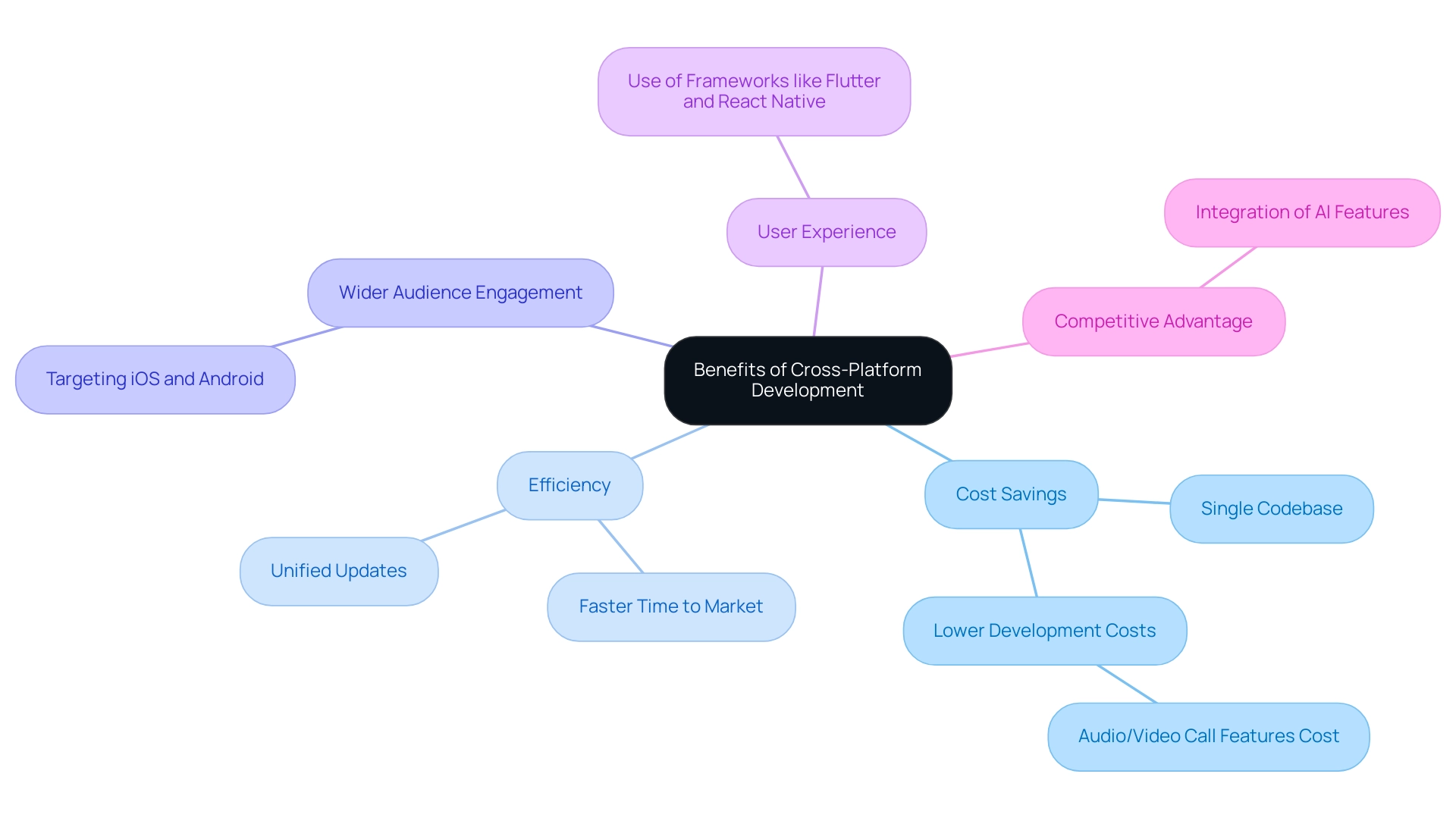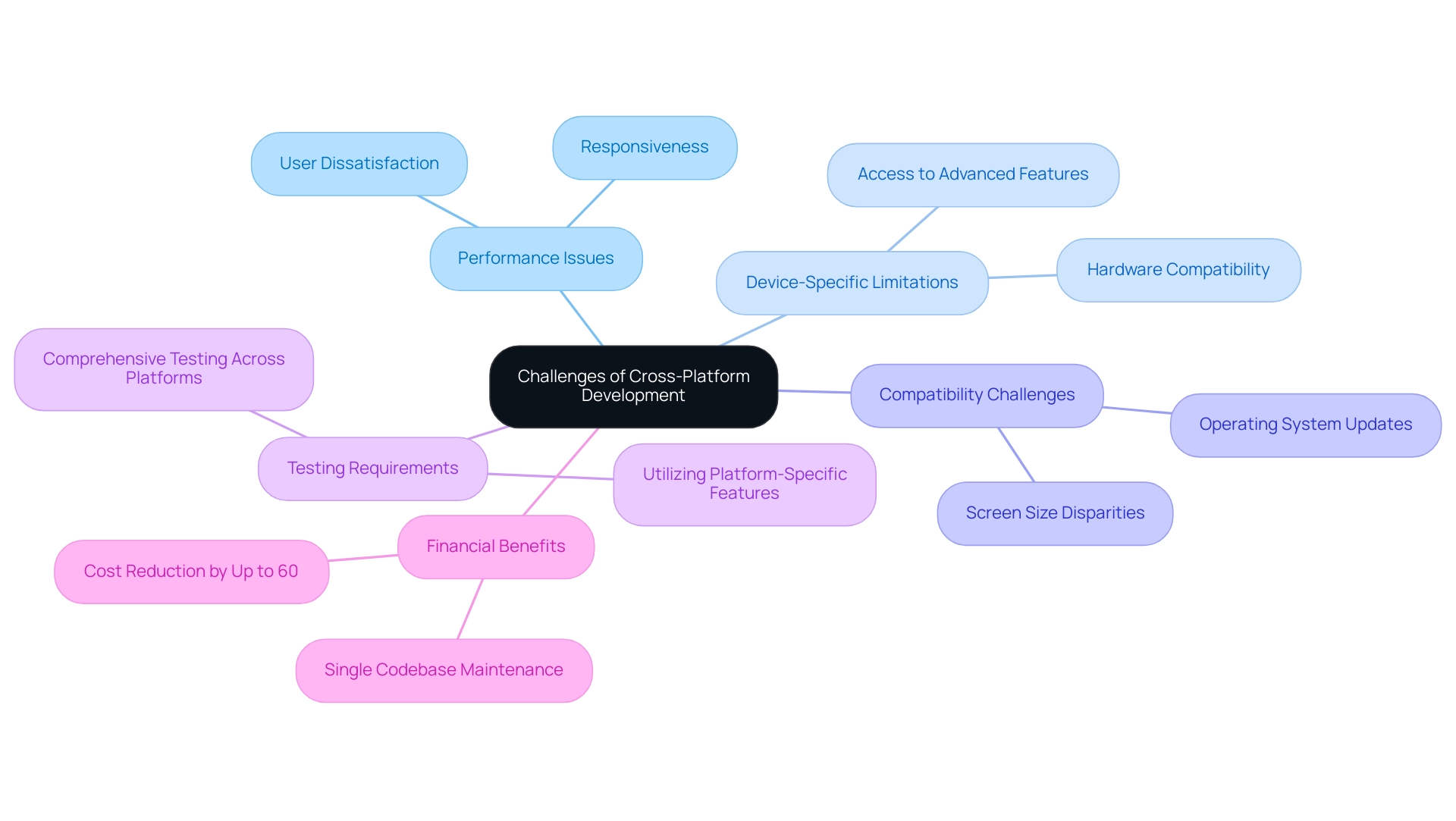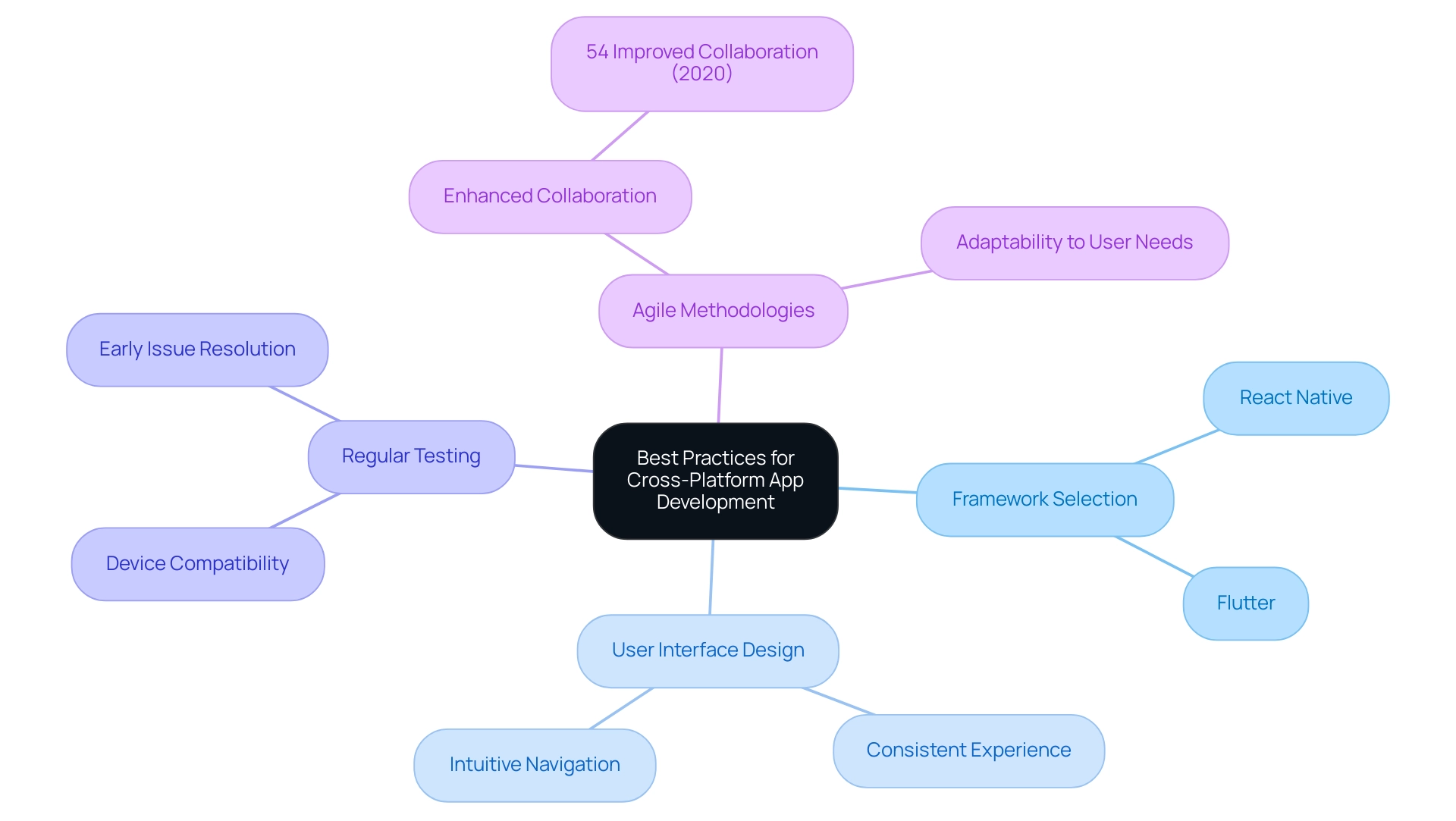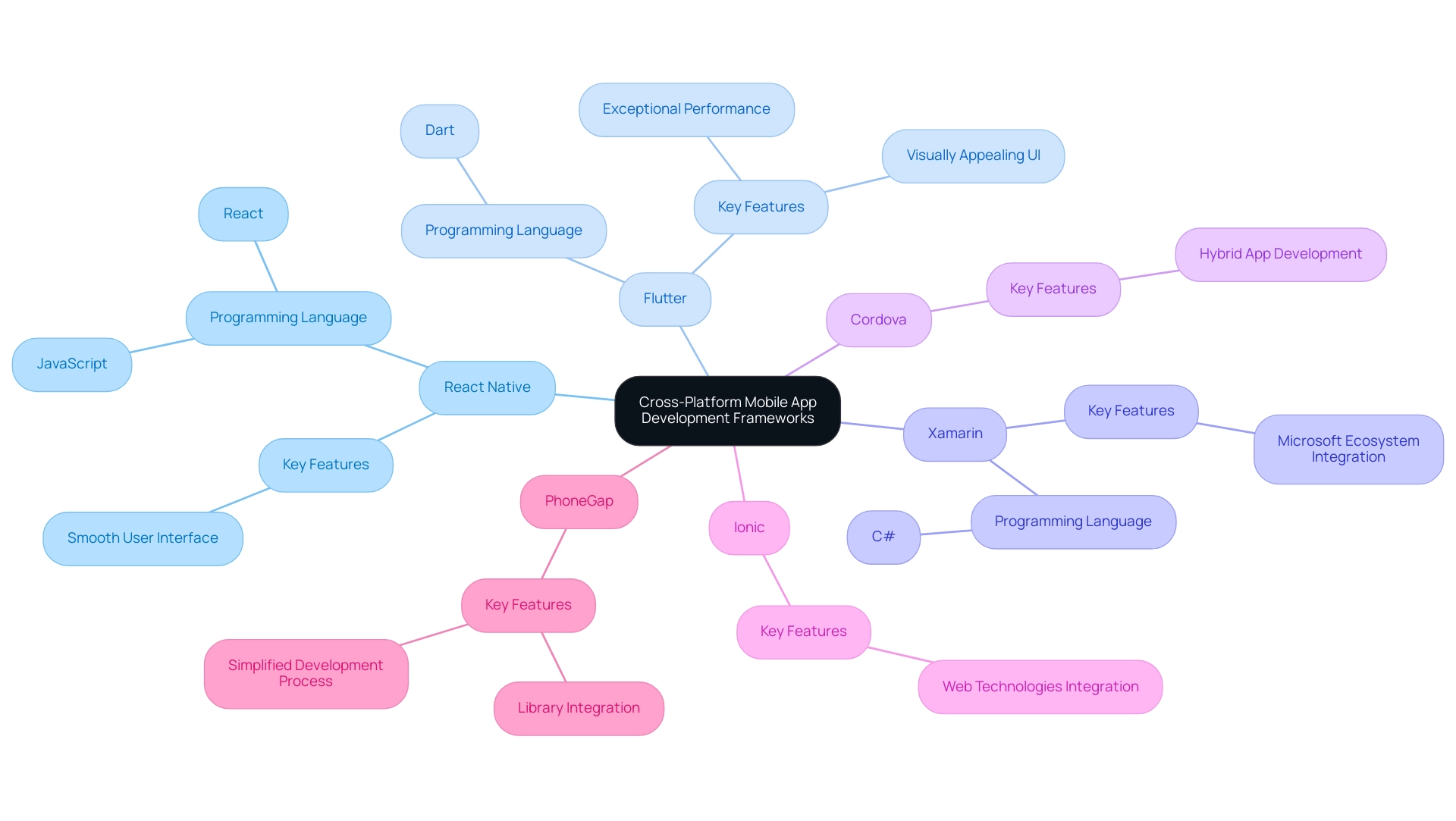Introduction
In the dynamic realm of mobile app development, cross-platform solutions are emerging as a game-changer, allowing developers to create applications that operate seamlessly across diverse operating systems with a single codebase. This innovative approach not only slashes development costs but also accelerates the journey from concept to market, making it an essential strategy for businesses looking to expand their digital footprint.
As the global demand for mobile applications surges, driven by skyrocketing mobile commerce sales, understanding the intricacies of cross-platform development becomes paramount. From the advantages of utilizing popular frameworks like React Native and Flutter to the challenges of performance and device compatibility, this article delves into the comprehensive landscape of cross-platform mobile app development, providing insights that empower organizations to navigate this competitive field effectively.
Understanding Cross-Platform Mobile App Development
Cross platform mobile apps development is transforming how software is produced by allowing developers to build programs that operate smoothly across various operating systems, such as iOS and Android, utilizing a single codebase. This approach not only lowers costs but also significantly shortens the time to market, making cross platform mobile apps development an appealing choice for companies aiming to expand their reach. As global m-commerce sales are projected to soar to $3.56 trillion by 2024, the demand for efficient and scalable mobile applications is more critical than ever.
The rise in mobile device usage reinforces the necessity of understanding cross platform mobile apps development to connect with a wider audience without inflating development budgets. Cross-platform mobile apps development plays a vital role in this process by utilizing frameworks that offer a suite of tools and libraries designed to optimize functionality and enhance user experience across various platforms. For example, DoorDash, the largest food delivery application in the United States, holds more than 50% of the market share, demonstrating the competitive environment in the food delivery industry and the effectiveness of integrated solutions.
Furthermore, with the anticipated integration of 5G technology, developers are poised to leverage fast data speeds and low latency, enabling them to deliver even more engaging experiences through augmented and virtual reality tools. Developers should focus on optimizing app performance for 5G, enhancing user experiences, and ensuring data efficiency to maximize the potential of these advancements. As noted by Hanny Q., a satisfied client who adopted a multi-platform food delivery solution,
- 'We have purchased the Food Delivery solution for our online food business.'
- 'It’s needless to say that we are amazingly satisfied with the end result. Thank you, Food Delivery Solution team!'
This underscores not only the practical advantages of cross platform mobile apps development but also the increasing market share and potential of such applications in today's competitive environment.

Benefits of Cross-Platform Development: Why Choose This Approach?
The advantages of cross platform mobile apps development are extensive and compelling for businesses that aim to optimize their strategies for mobile apps. By leveraging a single codebase across multiple platforms, companies can achieve significant cost savings—development costs typically range from $14,000 to $15,000 for features such as audio and video calls, which can require 300-400 hours of development time. This efficiency not only conserves financial resources but also accelerates time to market, empowering businesses to introduce services swiftly and respond to market demands.
Furthermore, maintaining a unified codebase simplifies the process of implementing updates and bug fixes, ensuring that improvements are universally applied across all platforms with minimal effort.
Furthermore, multi-platform software can effectively engage a wider audience by simultaneously targeting both iOS and Android users. This dual-market approach increases visibility and potential user acquisition. The utilization of contemporary frameworks, such as Flutter and React Native, enhances user experience by providing tools for crafting responsive and visually appealing applications.
As highlighted in the case study titled "AI-Powered Features Every Enterprise Mobile App Needs in 2025," the integration of AI features is becoming essential for enterprises as technology evolves. This trend highlights the importance of cross platform mobile apps development to stay competitive.
Himanshu Gautam, an expert in digital transformation, emphasizes this point, stating, "The integration of advanced features is essential for enterprises looking to stay competitive in 2024 and beyond." By embracing cross platform mobile apps development, organizations not only enhance their processes but also position themselves to realize significant long-term benefits.

Navigating the Challenges of Cross-Platform Development
While cross platform mobile apps development offers notable advantages, it also presents several significant challenges that developers must address. A main concern in cross platform mobile apps development is performance; often, multi-platform software does not match the smoothness and responsiveness of native programs, particularly in resource-heavy scenarios. Recent reports highlight that this discrepancy can lead to user dissatisfaction and retention issues if not managed properly.
Furthermore, developers frequently encounter limitations in accessing device-specific features such as advanced camera functionalities and sensors, which are critical for many modern applications. This limitation is compounded by compatibility challenges in cross platform mobile apps development, as differences in screen sizes and disparities in operating system updates can lead to inconsistent user experiences across devices. A notable case study titled 'Wait Time for Updates' illustrates that multi-platform apps require additional time and effort to support updates from Google or Apple, often lagging behind native apps in adopting new SDKs, which can hinder the app's ability to utilize the latest features and improvements.
To effectively navigate these hurdles, developers should conduct comprehensive testing across all platforms, ensuring that any platform-specific features are utilized to their fullest potential. Moreover, businesses can gain from the financial side of cross platform mobile apps development, as they can lower creation expenses by up to 60% by sustaining a single codebase for various platforms. Highlighting performance metrics and user engagement will be crucial as the industry progresses in 2024, especially when comparing apps that operate across different platforms to their native counterparts.

Best Practices for Successful Cross-Platform App Development
Success in cross platform mobile apps development hinges on adhering to several best practices. First and foremost, selecting the right framework is crucial; frameworks such as React Native and Flutter are widely regarded for their robust capabilities and extensive community support. As David Pawlan, an industry blogger, notes, "One of the pivotal considerations for hiring a mobile app developer is the seamless integration of 5G technology," underscoring its significance in enhancing app performance.
Furthermore, prioritizing user interface design is essential to ensure a consistent and intuitive experience across all platforms. Regular testing across various devices is essential, allowing developers to identify and resolve issues early in the creation process. Implementing agile methodologies can further optimize the process, as projects utilizing these approaches have demonstrated higher success rates, particularly in adapting to evolving user needs and market dynamics.
Significantly, in 2020, 54% of respondents indicated enhanced collaboration with colleagues in project management because of remote work, emphasizing the importance of agile practices in today's project environment. Moreover, the USA and Asia-Pacific nations are acknowledged as leaders in mobile app creation, demonstrating effective multi-platform environments that can impact project results. As companies progressively embrace cross platform mobile apps development, these best practices will continue to be essential in ensuring project success.

Top Frameworks and Tools for Cross-Platform Mobile Apps
In the ever-evolving landscape of cross platform mobile apps development, several frameworks and tools have emerged as industry leaders. As of 2024, React Native and Flutter are among the most popular mobile app development frameworks, reflecting their widespread adoption and effectiveness. React Native, created by Facebook, enables developers to utilize JavaScript and React to build mobile software that provides a smooth and responsive user interface.
Flutter, engineered by Google, utilizes the Dart programming language, renowned for its exceptional performance and visually appealing UI designs. Xamarin, supported by Microsoft, caters particularly to developers proficient in C#, making it a compelling option for those within the Microsoft ecosystem. Furthermore, tools such as Cordova and Ionic facilitate the creation of hybrid software, which seamlessly blend web technologies with native functionality.
As highlighted in the case study on hybrid apps, these applications provide a user experience similar to native apps while utilizing web technologies, offering the advantages of both types and allowing for broader compatibility and easier updates. Additionally, PhoneGap combines various libraries with existing code, simplifying the creation process for cross-platform apps. As Hamid M. Chishty aptly points out,
A lot of the stuff you do daily is now done on smartphones,
underscoring the critical role of these frameworks in contemporary application design.
Selecting the right framework for cross platform mobile apps development hinges on the specific requirements of the project and the existing skill set of the development team, ensuring that the chosen technology aligns with the strategic goals of the application.

Conclusion
Cross-platform mobile app development stands at the forefront of a rapidly evolving technological landscape, enabling businesses to craft applications that resonate with a broader audience while simultaneously optimizing resources. By leveraging a single codebase, companies not only reduce costs but also significantly accelerate their time to market. The insights presented in this article highlight the compelling advantages of this approach, from enhanced user engagement to the strategic integration of frameworks like React Native and Flutter, which are essential for delivering high-quality mobile experiences.
However, the journey is not without its challenges. Performance disparities and limitations in accessing device-specific features can pose significant hurdles for developers. It is crucial for organizations to navigate these challenges through diligent testing and by adopting best practices that prioritize user experience and agile methodologies. As the mobile app market continues to burgeon, particularly with the anticipated integration of 5G technology, the ability to adapt and innovate will determine success.
In summary, the landscape of cross-platform mobile app development presents a wealth of opportunities for businesses willing to embrace this transformative approach. By understanding the nuances of cross-platform solutions and leveraging the right tools and frameworks, organizations can position themselves at the forefront of the mobile revolution, ensuring they not only meet but exceed the evolving demands of their users. The future of mobile app development is here, and it is cross-platform.





